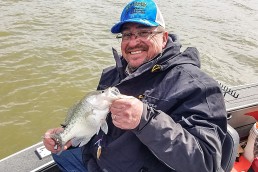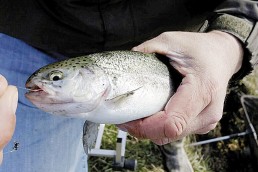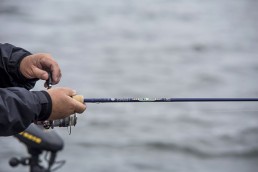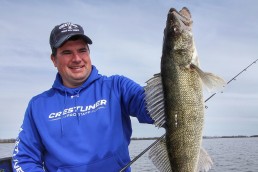When and How to Use Live Bait
SHARE THIS POST
The more you fish, the more you understand some things never change. Consider the night crawler, for example. More walleye are caught with a night crawler than all the other baits added together. If you want to master walleye fishing, learn how to fish a crawler. Crawler harness rigs, slow death rigs and the split shot rigs produce tons of walleyes.
A slow death rig normally uses a single hook and half of a crawler threaded up the hook to the knot. A special Death Hook that rotates wildly is most often used. The split shot rig is simply a split shot and a single hook. It might be a slow death hook or the standard hook.
Most rigs come with a bead configuration and multiple blade color. A mixture of blades and blade colors is suggested. Something with pink or purple works great on clear waters, something with flash or glitter in darker waters. UV rigs and glow rigs work well in dark or dingy water. Also—pay attention to the back of the blade. Is it copper, silver or gold? According to Ken Clark of Fish mas Charters, walleyes attack from the back; remember that. They see it coming and they follow it until they strike.
Crawler Harness rigs can be fished on the bottom, or for suspended fish. On many of our larger lakes, you will find schools of walleye suspended out over deep waters. Adding an inline weight and using depth and speed charts will show you exactly how much line to let out to reach a desired depth. The best speeds are .3 to .5 mph with the split shot rigs and up to 1.5 mph with the various spinner rigs.
A note for panfish anglers: the fastest way to locate a nice pod of perch, bluegills or crappies is trolling. Rigs like the Action Spin Snells on Bo’s Bluegill Busters draw in panfish. These are mini spinner rigs designed for panfish. You can also make your own. For the perch and the gills, add a large, fat Belgium worm. Crappie anglers add some type of plastic action tail or a minnow.
Most of our local lakes have a defined thermocline. We are finding the thermocline on most lakes is in the 20- to 25-foot range. What this means is that the bulk of the fish will not be deeper than this depth. Start at the weed edge and work outward, or look on your graph for suspended fish. The best speed for panfish is maybe .3 mph, up to 1 mph.
Another presentation—and a must have item—is the death hook. This camshaft designed hook rotates and turns in the water. Just recently we used this on a local river, and caught a mixed bag. Proper rigging is required.
Take a nice plump crawler and thread it over the hook all the way up to your knot. Start right at the tip of the crawler. Leave one inch hanging, and pinch off the rest. You can use this rig as is, or modify with a few beads and a Smyle Blade. A Smyle blade is a small wing-shaped blade that turns quickly, with minimal current or speed. It’s a good choice when the bite is tough or the fish are schooled tightly.
A spinner rig is the best search weapon for any type of panfish, bass or walleye. You cover water, and you throw flash and scent. The best trolling or drifting speeds starts near .4 mph and upwards to 1.5 mph. There are many ways to fish them. If trolling over weeds, use a bullet sinker. Place this onto the line; add a barrel swivel, then your rig.
Trolling open water, or up and down breaklines, points or a drop off, try a three-way rig. Tie on a three way swivel to your main line. Then, add a dropper line to your spinner. A third line is added to a bell or bass-casting sinker—you adjust this lead, and determine how high off of the bottom that you want your spinner to run. We generally start in the 1- to 2-foot range for a dropper.
Add a snap to that, and you can change sinker weights as the conditions change. This is a great search tool. Don’t drag the sinker; instead, feel the thump of the sinker hitting the bottom and being raised up and down. You can also use a bottom bouncer. The key to a bottom bouncer is for the sinker to bounce off the bottom. You want it to tick the bottom, not drag on the bottom.
Are you enjoying this post?
You can be among the first to get the latest info on where to go, what to use and how to use it!
The best way to plump up your crawlers—and keep your boat clean—is with ice. Ken Clark fills a small cooler with ice and adds his crawlers. They will plump up real fat while everything stays clean.
Walt Matan of Custom Jig and Spin is an avid panfish angler with decades of experience under his belt. He says watching your graph for the thermocline and fishing just above it easily helps catch summer gills. Another tip he passed on: if the thermocline starts at 25 feet, fish on the bottom for those bull gills that are nose down. Often, they are feeding on bloodworms!
I use the small Fish Hawk TD temperature gauge. Hook it onto your line, and steadily drop to the bottom. Reel it up, and it shows you the temperature at 5-foot intervals.
Walt Matan loves his Demon Glow teardrops, the Rat Finkie and the Flu Flu (a jighead with chicken feathers attached)—crappies go nut over these lures.
Crappies, gills, walleye and even bass will school up. When a pod of fish is located, vertical fishing can be best. Tipping an ice jig with a spike or a wax worm can make a huge difference. Minnows are always a good choice, but they require more caring-for in the heat. Leeches are a favorite of mine; small leeches work great on panfish, while larger leeches are deadly on gamefish. Use a round ball jighead on the gamefish.
An overlooked pattern that is great under windy conditions or a severe cold front is the slip float. The slip float allows you to fish deeper than a standard float would, keeps your lure into the strike zone longer and also provides a visual strike indicator. Slip floats work great, even on calm days. Cast it out, let the bait or lure sink to the proper depth and stat reeling in slowly. Walt Matan almost always has a rod rigged with a slip float.
“The key to any float, be it an adjustable casting float or a slip float is in the balance,” said Matt Straw, well known angler and author. Weigh down your float with either a jig or a few small split shots. The goal is having only your tip or stem showing. Under real windy days, try a float that is very long and slender. A properly balanced float will have just the tip of this float above the surface, making it easy for a fish to pull under.
The beauty of slip floats is that anyone can fish them. I like to double up. In many lakes, bass and walleyes are present. Fishing a slip float with a leech on the business end will draw tons of action from the gamefish. Slip floats can be fished in depths of 2 feet or 40 feet. They can be fished with just about anything on the business end.
Trolling and drifting allows an angler to cover more water. However, when it comes to panfish and bass, the fish will be schooled up, necessitating vertical presentations. Watch your graph and pay attention to the exact spot where a fish was caught. We still use the old Lindy marker buoys.
Land a fish, go another 50 yards—if you find nothing, spin back to the marker. Land another fish, stop trolling and work the pod vertically.
Lastly, live bait really shines under cold fronts. Placing a bait in its most natural condition on a fish’s nose will make it hard to resist. Extra tip, use hair jigs for all species—they really work under tough conditions. Cold fronts and lockjaws go hand in hand, and live bait will often be a meal ticket to success.
MWO
SHARE THIS POST
Did you enjoy this post?
You can be among the first to get the latest info on where to go, what to use and how to use it!
Jack Payne
Jack Payne is an accomplished angler and hunter who enjoys teaching others as much as learning from others. Seminar speaker, outdoor photography enthusiast, hunter safety instructor and volunteer at many events for both kids and adults as an instructor.



